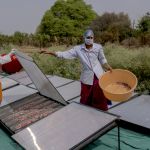A Blueprint for Productive Use of Clean Energy: An Accelerator in Nigeria Generates Solutions for Linking Mini-Grids to Agricultural Equipment in Rural Communities
There are over 70 mini-grids in operation in Nigeria today. Most of these isolated power systems are powered by a combination of solar power, battery storage and small diesel generators that provide back-up power when needed, with the goal of delivering reliable clean energy to communities that are accessing electricity for the first time. Many energy businesses want to serve these new communities, and with over 85 million Nigerians lacking access to grid electricity, a market for their services exists.
But serving a new community that has never had power presents some unique challenges — not only in Nigeria but across the developing world. It requires energy companies to find and convince customers — who typically lack the equipment and appliances to use power — to sign up for electricity services they’ve learned to live without. It also requires them to convince local businesses, generally in the agriculture processing sector, to swap out their existing (still serviceable) gas-powered rice and flour mills or cassava graters and invest in new electric versions — which necessitates investments that are hard for these local businesses to fund without access to affordable sources of financing. Energy providers are not equipment and finance experts, they are in the business of generating, distributing and selling power to consumers. But if users lack the means to use the power they sell, the energy providers’ revenue model fails.
The Challenges of Boosting Demand for Productive Uses of Clean Energy
Partnerships can help address some of these challenges. Ideally these involve an energy and equipment provider partnering to enter a new community, then working together to find customers, understand their needs and make investment decisions in tandem. These partnerships can also help inform some of the key decisions energy companies must make at the planning stage of projects, since cross-cutting expertise from equipment providers can help them avoid added costs later on. For instance, equipment providers can help them determine how big a battery bank to invest in and how far to extend their network infrastructure. And energy companies can advise equipment providers on which electrical loads make sense to serve with a mini-grid system, which can help these providers prioritize customers and determine which equipment models to retail locally.
But making these decisions collaboratively requires businesses to find partners that share interest in the same regions and value chains, and that have the operational capacity to deliver. It also requires the partners to line up the money to fund their customer engagement activities, and to make the right staff available at the opportune time — i.e., before a competitor swoops in on a preferred site. Finding the right partner and learning how to work collaboratively is difficult, and these partnerships often fail to materialize unless an external entity steps in to take on the coordination role. This is because energy use companies (such as equipment providers) and energy supply companies do not tend to interact with each other under normal circumstances, and they each have limited staff to lead coordination efforts.
Funding these demand-side efforts presents another key issue. It took decades for policymakers and their development sector partners to relinquish their “if you build it, they will come” approach to designing energy access programs, and to broaden their perspective to consider not only the need for more supply, but also the challenges of creating demand for energy services. To take one example: As recently as the period from 2000 to 2008, investment in supply expansion represented almost half of the nearly $4 billion in total investment the World Bank approved for energy access, whereas investment in productive use represented just 0.7%.
As awareness of the demand-side challenge in energy access has increased, there has been growing recognition among policymakers and development sector players that they must consider demand stimulation by funding productive uses of electricity — i.e., the use of electricity for income-generating activities, which are predominantly agricultural in rural communities — alongside supply-side infrastructure financing. And yet the need for financing for productive use equipment and the solar systems needed to power them remains large, with some estimates as high as $86 billion per year from 2020 to 2030 in sub-Saharan Africa. And even when sufficient financing is made available, it remains difficult to craft policy solutions that address the needs of the entrepreneurs who deliver the electric equipment and services to consumers.
What’s more, even well-intentioned policymakers often develop solutions that miss their mark. For example, the Nigeria Electrification Project allocated a considerable amount of development funding (US $20 million) to support demand stimulation alongside its mini-grid development efforts. However, these funds were provided as results-based financing that was disbursed only after verifying that the appliances had been deployed in communities. Although this type of support is necessary at later stages to scale a market, it is not the right solution for nascent markets in which emerging companies are still fine-tuning their business models and technologies. Since these businesses operate with limited funds and lack access to upfront financing, they are often unable to fund the deployment of productive use products in these markets in the first place, much less take advantage of results-based financing on offer only after successful deployment.
These are some of the challenges that make the implementation and ongoing viability of clean energy access projects difficult. So how can the sector work more effectively to make productive use happen in rural communities?
A blueprint for productive use of mini-grid energy
Nigeria’s Rural Electrification Agency (REA) and RMI are addressing this need by enabling the doers, the people ready to roll up their sleeves to find the right partners and develop productive use solutions that work in challenging markets. We’re doing this by providing them with the short-term coaching and strategic matchmaking they need as they learn to do something new, in lockstep with flexible upfront funding that enables them to test these new and often risky ideas.
In a little over a year, we’ve forged partnerships with nearly 30 organizations to form eight teams that are designing and testing energy-agriculture business models. Each team includes at least one agriculture appliance company and at least one mini-grid provider, which work together to sell both appliances and mini-grid electricity to new customers who currently have neither. The teams are now electrifying productive uses of Nigerian mini-grid electricity in almost 20 pilot sites across the country, testing the viability of 11 business models. These models range from using electric two-wheelers to run farmer extension services, to electrifying existing processing operations like cassava grating and maize and rice milling, which are currently powered by diesel.
If implemented at scale in Nigeria, these productive use efforts are expected to reduce greenhouse gas emissions by 1.4 million tons of CO2 by 2030, and by 7.4 million tons over the full life-cycles of the supported electric machinery. They’re also projected to create or improve over 150,000 jobs and positively impact the livelihoods of nearly 4 million Nigerians. This approach can also provide a blueprint that other companies and projects can use to scale the productive use of mini-grids in other countries and regions.
As this project demonstrates, productive use can’t happen without strategic partnerships. Energy developers, equipment providers, and agriculture and value chain experts each have different pieces of the puzzle. To establish and grow productive uses of mini-grid energy, it’s essential to enable these actors to contribute their unique knowledge to the design of business models that bring electric-powered equipment (and the services enabled by these devices) to customers in remote locations.
In Nigeria, the Energizing Agriculture Programme (EAP) Innovation Accelerator, co-led by RMI and the REA, is providing the ecosystem to make these partnerships happen. After identifying a problem on the agriculture side that electricity can solve (e.g., how to reduce energy cost volatility and improve the efficiency of oil palm milling), the accelerator started by identifying companies with a business interest in solving that problem. It then connected them with energy providers they could partner with, and with market experts who could advise them in developing and fine-tuning their business model to reach this new market. By bringing these actors together and tasking them with solving a specific problem, the accelerator created a space for collaboration and problem-solving, enabling them to work through pressing challenges and technical questions and identify concrete solutions (e.g., co-developing a lease-to-own business model for electric palm oil milling equipment). By hosting match-making sessions and bootcamps, it provided opportunities for peer-to-peer networking focused on sharing cross-sector expertise across agriculture and energy, and helped foster the relationships these teams needed to make joint projects happen. Through close follow-up and problem-solving support by a team of dedicated coaches, the accelerator converted these early conversations into real partnerships with concrete project commitments, and provided flexible funding to implement pilots to test the proposed business models.
The EAP, with partners like VIDA and ESMAP among others, will continue to provide Innovation Accelerator companies with an ecosystem of support, helping to identify and advance a concrete investment pipeline to scale viable agriculture electrification models. But these companies will need follow-on financing to access the growth capital they need to expand into new markets and communities.
To that end, this year the accelerator’s pilots will start to provide us with the data that shows which models are viable and can scale. This information, alongside a concrete pipeline of new projects that these companies will pursue after they have refined their business models through the accelerator, will be crucial to informing investment decisions by funders. These funders’ participation in the ecosystem is vital, as they will provide the financing these companies need to scale.
In the coming months the EAP and its partners will amplify the lessons and insights learned from the current Innovation Accelerator pilots, with a special focus on sharing the information that investors need to make their funding decisions. To keep abreast of these findings and other news surfacing from the EAP, please visit the program’s website here.
Scarlett Santana is the Principal at the RMI Global South Program.
Photo courtesy of Maheder Haileselassie / IWMI.
- Categories
- Agriculture, Energy, Investing
![The Clock is Ticking on Energy Access: Exploring Factor[e] Ventures’ Big Bet on Mini-Grids The Clock is Ticking on Energy Access: Exploring Factor[e] Ventures’ Big Bet on Mini-Grids](https://nextbillion.net/wp-content/uploads/Fig.1.FactorE-150x150.png)


